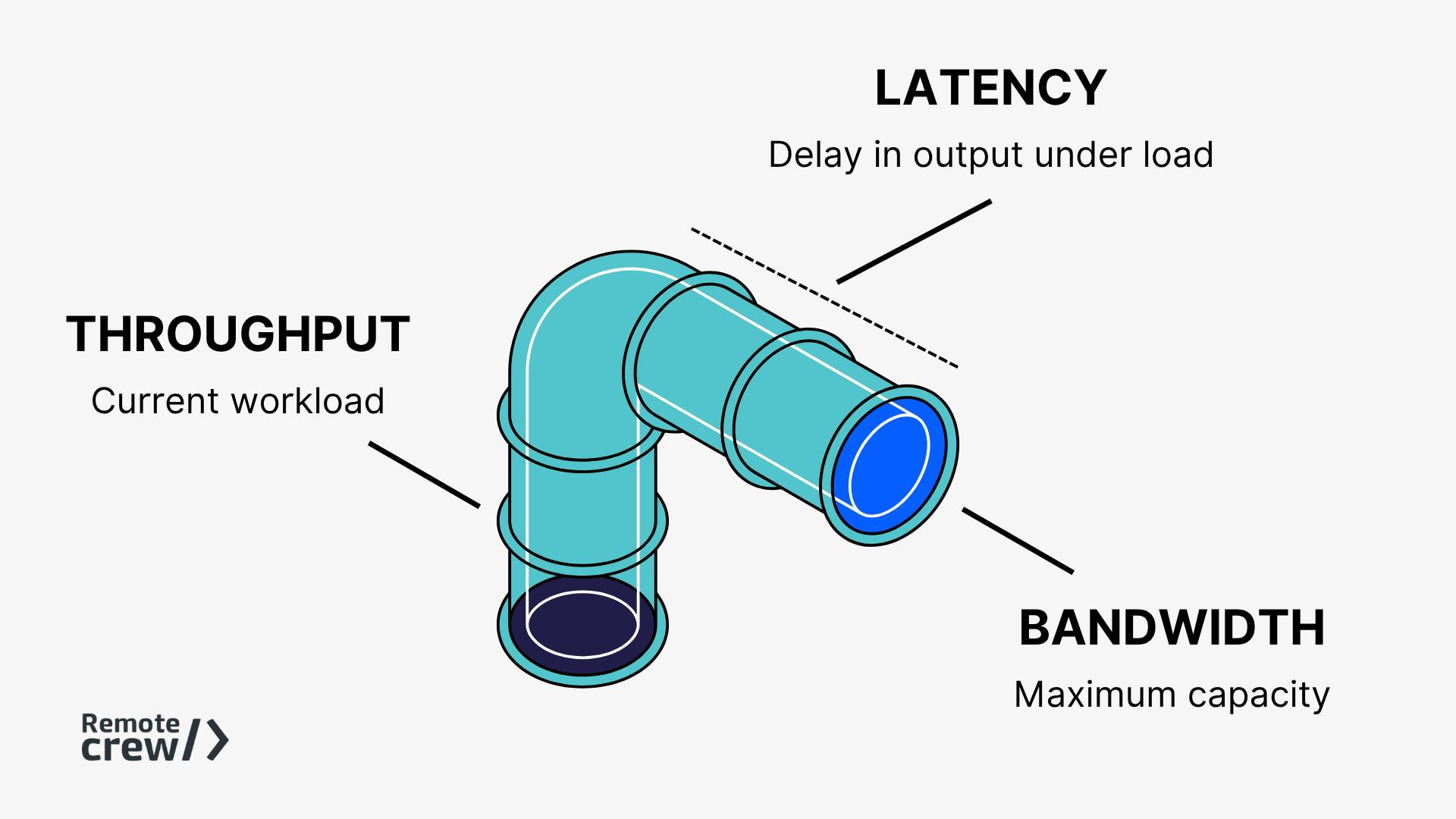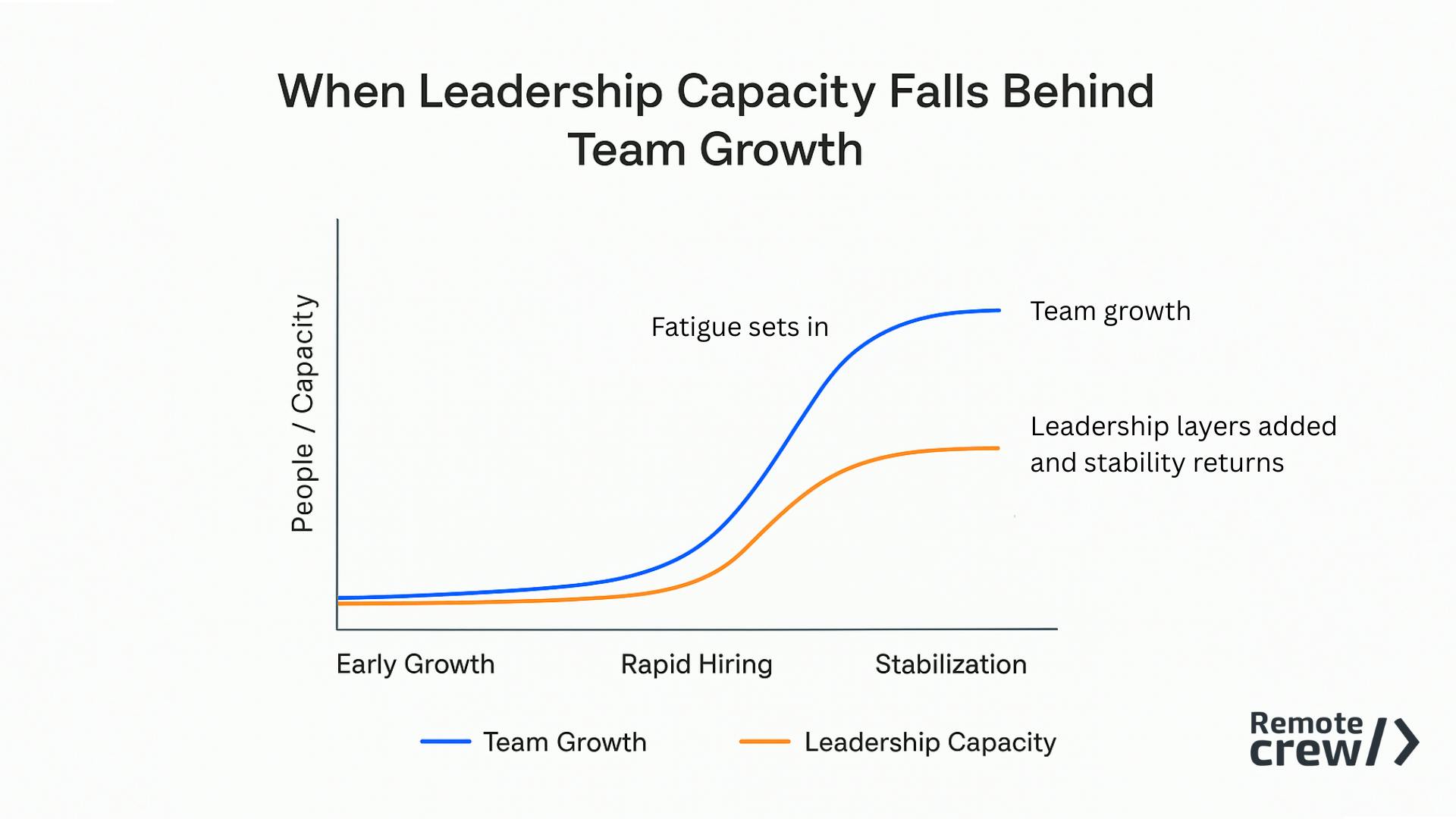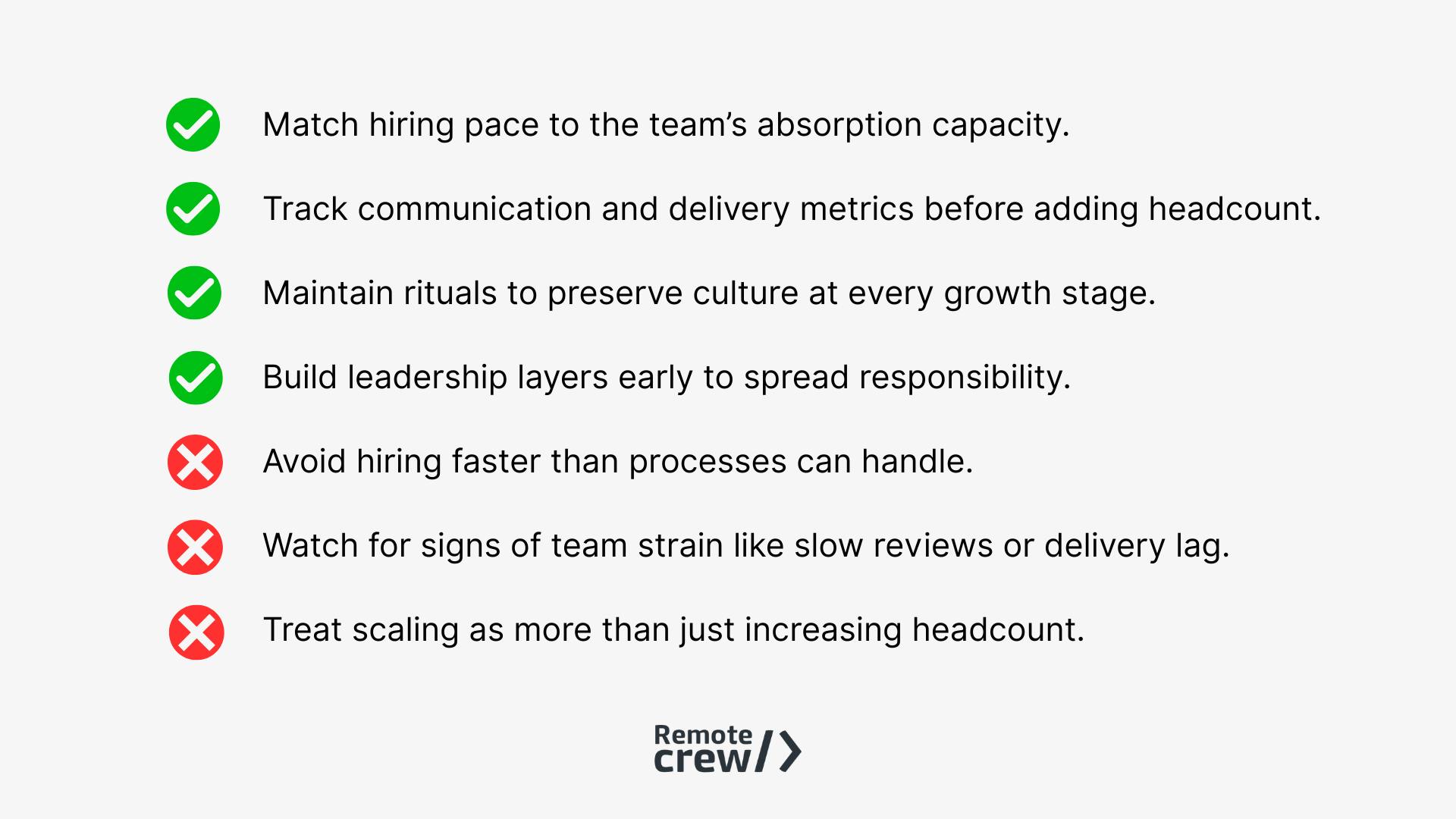Scaling a software development team is never as clean as it looks in presentations. That’s just the reality of taking bold swings. It’s messy.
I’ve found that the “mess” of scaling usually hides in:
- How fast new hires absorb context
- How clearly expectations are communicated
- How evenly the workload and ownership are distributed
It happens more often than people admit. We see teams rush to hire, add headcount faster than their systems can adapt, and suddenly, coordination starts to slip.
Those small delays can turn into missed reviews, context gets lost between handovers, and before you know it, everything has descended into chaos.
The first real incident exposes the cracks.
It’s those second and third-order consequences that keep me up at night.
Here are my seven hiring principles that make scaling cleaner, calmer, and more predictable:
- Match hiring velocity to the team’s absorption rate.
- Design hiring playbooks that scale before the pressure hits.
- Prioritize communication depth alongside technical ability.
- Make onboarding a living reflection of your culture.
- Use delivery metrics to guide when to open new roles.
- Grow leadership capacity through internal progression.
- Align hiring teams around shared velocity and quality goals.
Keep reading, and I’ll tell you why these hiring principles matter.
How To Keep Culture Aligned While Scaling Fast
I see culture erodes fastest when speed outruns alignment.
You’ll find that each new developer brings habits, preferences, and unseen biases into a shared environment.
Rituals matter. Team syncs that sound redundant often save relationships.
We always encourage brief retros after each milestone, even across multiple time zones.
That’ll keep context circulating. New hires will absorb norms faster when exposure is structured rather than improvised.
I’ve included some examples of culture retention tactics at different growth stages in the table below.
Team Size | Ritual Introduced | Purpose | Frequency |
5-10 devs | Weekly retros | Maintain shared voice | Weekly |
10-25 devs | Async daily updates | Prevent misalignment | Daily |
25-50 devs | Cultural mentor pairings | Reinforce values | Ongoing |
50+ devs | Internal demos | Build cross-team visibility | Bi-weekly |
I want you to start thinking about ways to foster team culture while you’re rapidly hiring.
At Remote Crew, we run hiring like an engineering system.
We focus on making sure everything is:
- Measurable
- Testable
- Continuously improved
Our team works with you to attract candidates who are a good fit for your team culture and can hit the ground running, where possible.
Think About “Load Capacity” Instead of Headcount
We’ve found that hiring velocity without careful discipline just results in churn.
Momentum is important, but we don’t want it to fracture delivery.
What we’ve seen is that teams that expand too quickly without process refinement burn out or implode under coordination pressure.
This is why we train hiring leads to think in “load capacity” instead of headcount.

Every engineering system has throughput limits, and the same logic applies to humans.
Scaling responsibly means understanding when a team can absorb new members without rewriting every hiring playbook.
We encourage companies to track two lagging indicators before increasing headcount:
- Communication latency
- Review cycle length
Those reveal bottlenecks that hiring can’t solve.
Before expanding your team, I want you to keep an eye on these metrics:
Metric | Ideal Range | Risk Signal | Corrective Action |
Code review turnaround | <24 hours | >48 hours | Introduce review rotation |
Sprint delivery ratio | 80-90% | <70% | Reassess backlog sizing |
PR comment density | Moderate | Excessive | Improve spec clarity |
Async response lag | <4 hours | >8 hours | Create timezone handover rules |
What we've seen is that once these numbers drift, new hires compound dysfunction instead of reducing it.
That’s why the hiring process itself has to act as an early stabilizer.
The best time to prevent coordination breakdowns is before someone ever joins the team.
At Remote Crew, we spend most of our energy upstream.
What does this look like? It’s usually about refining the filters, signals, and feedback loops that predict whether a candidate will strengthen or strain a system already under load.
My team at Remote Crew focuses on finding people who work well in distributed environments, communicate clearly, and adapt fast.
We pay attention to how candidates explain decisions, handle feedback, and manage uncertainty.
Those small signals usually predict how they’ll perform when things get messy.
Can Technical Leadership Scale Faster Than The Team?
It’s common for the first engineering lead to go from managing five people to twenty almost overnight.
They’re still writing code, running standups, handling timelines, and managing performance, all at once.
That’s usually when fatigue creeps in quietly. Deadlines slip, and small problems start to multiply.

The solution is to add leadership layers sooner than you think you need them.
Promote professionals who already understand how the team works, and give them the space to lead.
We’ve found that mentorship makes this work.
When mid-level engineers are coached to share context and make small decisions, senior leads can focus on the bigger picture.
As leadership spreads out, the team becomes more stable.
How Remote Crew Keep Scaling Stable For Ambitious Startups
At Remote Crew, we take a people-first approach to building hiring processes.
Our systems make hiring and scaling feel predictable instead of chaotic.

We focus on three things:
- Smart pipelines that match your hiring speed and growth goals.
- Structured onboarding that teaches communication norms and team rhythms from day one.
- Integrated workflows that connect naturally with Slack, Jira, and GitHub.
Each client gets a setup that adapts as they grow.
We avoid rigid systems and create flexible ones that handle change without losing stability.
This helps spot strain early, before it turns into missed sprints or team fatigue.
At Remote Crew, our goal is to make scale feel calm, steady, and under control.
We know that real progress comes from growing without losing balance.
Keep these ideas in mind as you scale:
- Growth should feel steady and sustainable.
- Every new hire should strengthen communication.
- Leadership depth should develop early.
- Team culture rituals help teams stay aligned.
- Metrics reveal when it’s time to pause and recalibrate.
- Scaling works best when progress feels calm and deliberate.
Do you need remote technology recruitment services for your startup? We help startups hire the best remote talent. You can start hiring with Remote Crew today.
Tech hiring insights in your inbox
From engineers to engineers: helping founders and engineering leaders hire technical talent.
We will only ever send you relevant content. Unsubscribe anytime.






